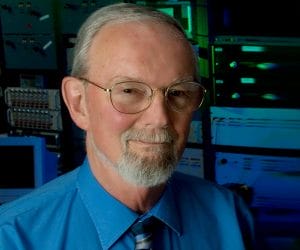“I really didn’t make an informed decision” about what to study, Thorp said. “I was told since I was good at math and physics I should be an engineer.” So at 17 years old, he chose the best scholarship offer — from Cornell University — and studied electrical engineering there, earning his bachelor’s, master’s, and doctorate degrees all in a row, finishing in 1962 at age 25. He stayed at Cornell: he was offered a teaching job there. “The first Dean I worked with was opposed to young faculty with no industry experience,” he said later, so he took side jobs in industry to get that experience, most notably with American Electric Power, where he met Arun Phadke, another electrical engineer, in the mid-70s. AEP was working on a problem: the electrical power grid in the U.S. was increasingly important, but a problem in one spot could spread over the grid, causing widespread blackouts. In addition, small generation facilities such as microhydro plants, windmills, and PV power systems made it all more complex. To keep up, AEP researchers wanted to switch from protection and control of the grid using mechanical relays to computers, but found it expensive and difficult to synchronize it all, which was key to making it work. They were a good team: Thorp was a brilliant theoretician, and Phadke was especially adept at conceptualizing and knowing what hardware would work, so they tackled the problem together.

To synchronize everything, Thorp first looked into the radio time signal transmitted from Ft. Collins, Colorado, from the atomic clock in Boulder. Not good enough: since it was transmitted from the ground in the middle of the country, the time for the signal to arrive at different parts of the grid varied by as much as 20 milliseconds; they’d need a better time reference. In 1978, the U.S. military launched the Global Positioning System, which required highly accurate timing itself. Thorp was able to use the time signals from the GPS satellites to make the grid monitoring system work. What they came up with “could do more than just monitor and record,” said the Franklin Institute. Having such exacting measurements and information tied into computers provided “a wide-area snapshot of the grid, a key tool to protect against blackouts when the power grid is under stress.” The grid-tied devices Phadke and Thorp invented in 1988 are called “phasor measurement units,” and they not only reduce the chance of blackouts, but when they do happen, helps to keep them from spreading from system to system over the grid, as well as help power systems get back online faster. The first step in creating the so-called “smart grid.” In 2008, the Franklin Institute awarded Thorp and Phadke the Benjamin Franklin Medal in Electrical Engineering “for pioneering contributions to the development and application of microprocessor controllers in electric power systems … playing a key role in diminishing the frequency and impact of blackouts.” Thorp retired from Cornell in 2004 after 42 years — and then accepted a job as a professor and department head of Electrical and Computer Engineering at Virginia Tech, where Phadke had been teaching since 1982. He was later awarded Emeritus Professor status, and never really retired. He died on May 2, at 81.
